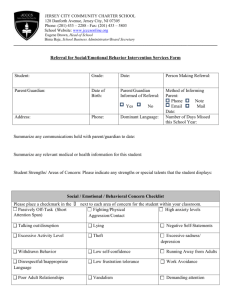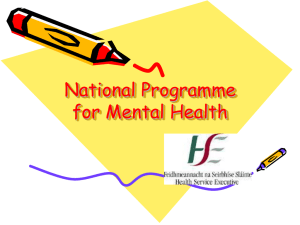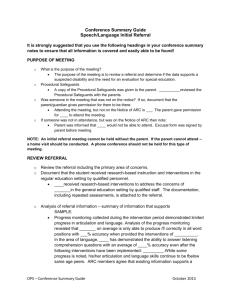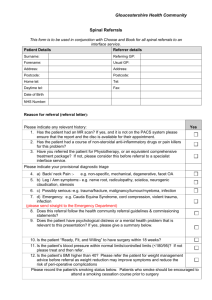Non Public Referrals - School District 622
advertisement
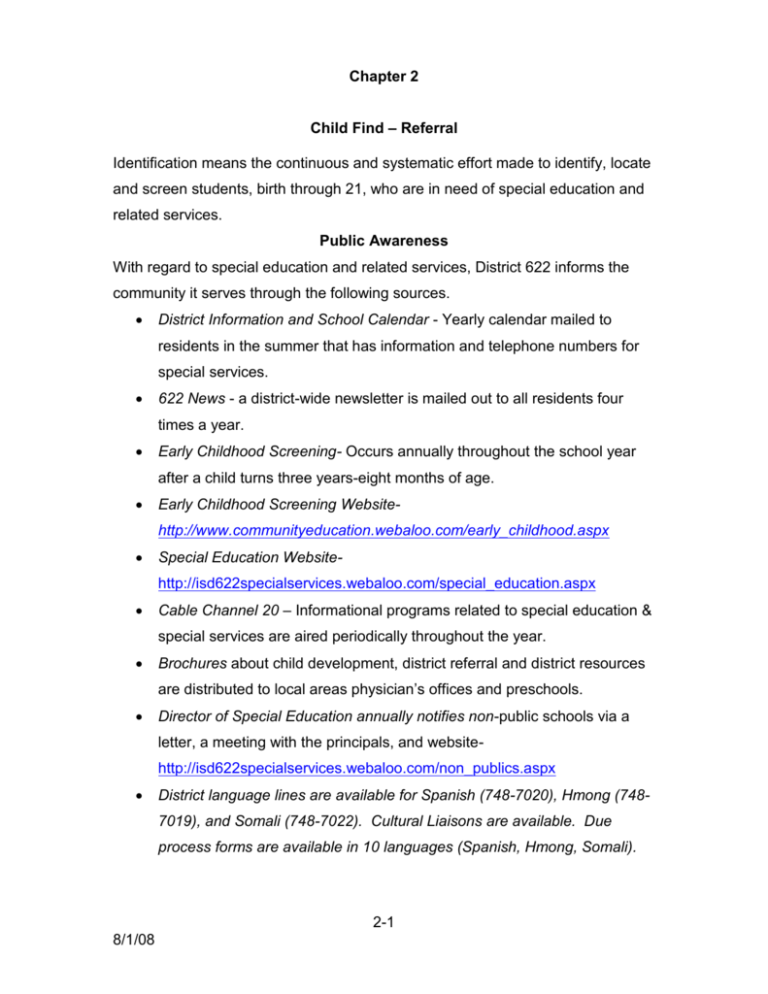
Chapter 2 Child Find – Referral Identification means the continuous and systematic effort made to identify, locate and screen students, birth through 21, who are in need of special education and related services. Public Awareness With regard to special education and related services, District 622 informs the community it serves through the following sources. District Information and School Calendar - Yearly calendar mailed to residents in the summer that has information and telephone numbers for special services. 622 News - a district-wide newsletter is mailed out to all residents four times a year. Early Childhood Screening- Occurs annually throughout the school year after a child turns three years-eight months of age. Early Childhood Screening Websitehttp://www.communityeducation.webaloo.com/early_childhood.aspx Special Education Websitehttp://isd622specialservices.webaloo.com/special_education.aspx Cable Channel 20 – Informational programs related to special education & special services are aired periodically throughout the year. Brochures about child development, district referral and district resources are distributed to local areas physician’s offices and preschools. Director of Special Education annually notifies non-public schools via a letter, a meeting with the principals, and websitehttp://isd622specialservices.webaloo.com/non_publics.aspx District language lines are available for Spanish (748-7020), Hmong (7487019), and Somali (748-7022). Cultural Liaisons are available. Due process forms are available in 10 languages (Spanish, Hmong, Somali). 2-1 8/1/08 Birth to 3 years old District 622 is part of the Early Intervention Alliance (EIA), which is a consortium of five school districts. Each child is assigned a service coordinator and evaluated by a multidisciplinary team. Home-based services are provided from birth to age 3 through an Individualized Family Service Plan (IFSP). EIA also makes referrals to other agencies as needed. 651-430-6700: Washington County Early Intervention Network Program 651-604-3700: Ramsey County Central Intake & Referral 3 to 5 year olds 651-604-3700: Early Childhood Information Referral Office (Washington & Ramsey Counties) 651-748-7280: Early Childhood & Family Programs 651-748-7289: Early Childhood Screening 7 to 21 years of age A Pupil Needs Committee (PNC) operates in each of the District 622 schools. The PNC has the responsibility to ensure that documented interventions have been completed. The PNC will identify special education evaluation needs, formulate the evaluation plan, and appoint a facilitator for the process. Members of the PNC have the responsibility to ensure due process requirements are followed in reference to all aspects of the evaluation, service delivery, and reevaluation process. Alternative Learning Center (ALC) For currently enrolled 622 students, the PNC must review and explore all available service/support options within the building. ALC staff will make efforts to obtain the most recent evaluation and individualized education program (IEP) for special education students new to the district and applying to the 622 ALC. When a resident student applies directly to District 622 ALC, the ALC staff will verify whether or not the student had an active IEP in their most recent school of 2-2 8/1/08 enrollment. If the student had an active IEP, the ALC staff will notify the previous case manager, counselor, and building special education coordinator. ALC staff will make efforts to obtain the most recent evaluation and IEP before the student can begin in the ALC program. Private (Nonpublic) & Homeschool On an annual basis, a letter is sent to the nonpublic schools in the ISD 622 attendance area regarding the availability of special education services for students being served within the 622 school district boundaries. An offer is made to provide in-service opportunities on making referrals to special education. When a referral is made to the public schools from a nonpublic school, the standard due process procedures are followed. District 622 Non-public Contacts 651-748-6944: Heidi Shaback (Initial Contact, St. Peters, Christ Lutheran) Note: In Minnesota Charter Schools are treated as Public Schools and are responsible for their own special education services. Referral Referral is a formal, ongoing process for reviewing information related to students who are suspected of having disabilities and show potential signs of needing special education and related services. The process includes reviewing a student’s screening information and the interventions (if they were completed) to make a decision about whether or not to conduct a formal education evaluation. This occurs as a result of no progress being made on at least two scientific research-based interventions or as a result of a parent making the referral. Interventions are planned, documented, systematic efforts on the part of the regular education staff to resolve apparent learning or behavioral problems. 2-3 8/1/08 Documented Interventions Pre-referral interventions are the responsibility of general education teachers or staff. Documentation of at least two scientific research-based interventions is required while the pupil is in the regular education classroom, before the referral to special education. Interventions need to be implemented for a minimum of 4 – 6 weeks. The effects (positive or negative) of the attempted interventions should be carefully monitored and tracked. The teacher(s) for that student must provide the documentation. A special education assessment team can waive this requirement if they determine that the need for such evaluation is urgent and there is a reason to suspect a disability. This section however, cannot be used to deny the student’s right to a special education evaluation. Documented interventions are not required for referrals for children from birth through entrance to kindergarten. Response to Intervention (RTI) aligns with the need for two scientific research-based interventions required for special education assessment. Tier one and Tier Two RTI interventions are the responsibility of general education. There may be times when a special education teacher is co-teaching a classroom and implementing specialized instruction for all of the students. This may be a Tier Two intervention for some regular education students. This is only allowed when it is the best way to meet the needs of the special education students Individualized Education Plans. Examples of Behavioral Interventions Point system with incentives Cuing system for appropriate behavior Home note system Systematic recognition of desired behavior Behavioral contract for privileges at home or school Examples of Academic Interventions Modified or individualized instruction Modified assignments 2-4 8/1/08 Adapted tests and/or grading system Peer tutoring Assignment log or homework tracker “chunking” of work into smaller units Learner Performance Review (LPR) Form The form is submitted to the building principal or the pupil needs committee in order to determine if formal evaluation is required. The principal or pupil needs committee will review the referral and sign it. If it is not complete, it may be returned to the referring teacher for additional information. Building teams are encouraged to collaborate with the referring teacher, assisting in designing meaningful interventions and documenting the results. Referral Review After a referral is submitted and prior to conducting an evaluation, the team shall conduct a review of the student’s performance in the following areas: intellectual functioning, academic performance, communicative status, motor ability, vocational potential, sensory status, physical status, emotional status, emotional and social development, and behavior and functional skills as noted in the Learner Performance Review Form. Each area must be considered but it might be determined that only specific areas are in need of evaluation. If a formal evaluation is required, a facilitator is assigned and responsible for scheduling and conducting an evaluation planning meeting to review the referral information and to determine areas that need to be evaluated. The multidisciplinary evaluation planning team must include: a licensed special education staff member the principal or another administrative designee such as a special education coordinator or supervisor the student’s general education teacher(s),(at least one of them) the referring person, if different than above, and the parent 2-5 8/1/08 the student (age 18 or older) Efforts must be made to include the parents in the planning process. If the parent does not respond to repeated documented attempts to contact the school, building teams can still meet without parents. However, documentation of the attempted contacts and/or the parent’s request to proceed without them MUST be noted in the student’s special education file. Parent Initiated Referral When a parent requests an evaluation for special education (whether verbal or written), it is the district’s responsibility to follow-up with this request. A documented response to the parent request should be made within 10 school calendar days. Since parent requests for evaluation are often initiated out of frustration over the lack of the student’s school progress and not because the parent believes the student has a disability, it is recommended that the Principal, Asst. Principal or Dean and the student’s general education teacher meet with the parent to clearly establish the issue of concern. The parent and the school staff should discuss whether to refer to special education or to possibly develop and encourage the use of documented interventions that might address the concerns. Interventions are not required (but may be suggested) in order to act on a parent referral. The school district cannot however delay evaluation if the parent is insistent that they believe the student is disabled and want the evaluation completed. Under no circumstances should any school staff advise parents that requesting an evaluation in writing can circumvent the intervention process. If the team, including the parents, makes the decision not to pursue a special education evaluation, this decision should be documented in the student’s file via the Prior Written Notice. If the decision is made to conduct a formal evaluation, the Learner Performance Review form should be completed and the evaluation process should be followed. Non Public Referrals When a referral is made to the public schools from a non-public school, 2-6 8/1/08 the referral and evaluation procedures outlined in this chapter are followed by the non-public. Staff will attend the Pupil Needs Committee (PNC) at the building to which your school is assigned for purposes of discussing the need for a special education evaluation. The PNC team will meet with the non-public school classroom teacher and/or a counselor/principal from the non-public school to discuss what the concerns are regarding the students, what interventions have been tried and whether or not special education evaluation would be reasonable. If evaluation is required, a public school staff will complete an evaluation. If a parent makes the referral, we still ask that the student’s non-public classroom teacher bring forward the referral. Non-Public school contact: 651-748-6944: Heidi Shaback, School Psychologist Home School Referrals Home school referrals are facilitated by the student’s attendance area school. When a family registers with Community Education for home school, an enrollment form is completed. If a parent indicates a suspected disability, the Community Education Office will notify special services and a representative will contact the family and offer to review the concerns with them. 2-7 8/1/08



